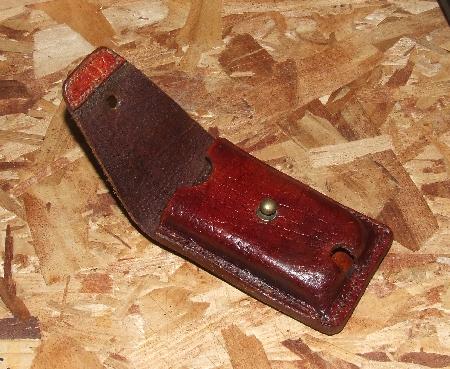-
Posts
5,923 -
Joined
Content Type
Profiles
Forums
Events
Blogs
Gallery
Everything posted by fredk
-
I reckon you'd need to PM a moderator or Joanna
-
you need to use sewing machine oil. Try a local knitting/sewing shop.
-
I can't access that picture
-
First questions; do you thin the paint before application? allowing the first two or three coats to soak into the leather then building up the colour with more applications of the thinned paint?
-
I have some basic starter kits left over from some classes. They have most of that kit but at 1/10 the price I don't want to put them up here but if you PM me I'll send you the list of items and price
-
oopsy
-

How to make a watchband with edge coating tutorial
fredk replied to RockyAussie's topic in How Do I Do That?
Nice tute. Is that an oil can you use as a glue pot & applicator? -
I concur, probably finger nail scratches. Ways to remove? burnish with a flat piece of glass which has a rounded edge. These are sold as burnishers; example - https://www.amazon.co.uk/Leathercraft-Glass-Slicker-Burnishing-Leather/dp/B004JAOB2K You can get these cheaper than this or you can make your own. For small nicks and marks you can generally reduce them with a spoon end modelling tool or even a teaspoon, but for large areas like this you need the glass plate Ways for it not to happen? cut finger nails close, be careful or give up leather work.
-
I used two needle files on the inside, one round rat-tail for the ends and a flat for the sides. I only gave the insides a bit of a wipe with them after I went round the outside with a flat diamond plate and some fine whetstones. The files were wiped over the inside lightly to remove any burr raised
-
I find that indelible marker ink is alcohol based. I remove it with meths. I can also get it in every colour. I use them for fine 'painting' on leather. Sometimes the markers are sold as 'paint' pens but they have ink in them not paint.
-
tbh, if its just the edge of a piece of plastic I would use a 'Sharpie' or indelible marker pen. It'll be less fuss than priming and painting and it will last just as long.
-
Not only this, but also which type of veg tan to use. I mean, if you use back-bone, even thin it'll not wet mould corners easily, use belly and you can stretch it over and around the corners before locking it down. How you lock it down at the corners matters; a tight fitting outer frame or stapling will keep the leather tight. Belly leather need not be thin, it can be thick too. Wet moulding also has a tendency to harden leather up a bit so belly tightens up
-

Quick cell case
fredk replied to plinkercases's topic in Purses, Wallets, Belts and Miscellaneous Pocket Items
Nice. I use one of that style myself Might I suggest; make sure you can the phone out of the case. I made mine just short of the length of the phone. I found I cannot grip the phone to get it out so I punched a finger hole centre bottom so I can use one finger to push the phone upwards until I can grip it -
Mike, I use K&S brass. I get it either locally from a craft shop or through ebay. HDPE, nylon, delrin or acetal might do the job. They are probably a bit more flexible than the metals, unlikely to break and no adverse reaction. Probably need a piece thicker than usual metal piece to match stiffness if that is needed Deviation; A friend bought a brand new Alfa. 2 weeks later his rear window dropped into the car. The metal under the rubber window gromit had rusted completely away. Lancia stopped selling cars in the UK because they could no longer afford the 'anti-corrosion' warranty claims.
-
your *may not be an actual word - I know as 'spider's legs I've encased brass into leather as a support for about 16 years now. Never had a problem with staining. Used with both Veg-tan and Chrome-tan. I usually use only pure brass hardware fittings, again no problem of verdigris or staining. But I have replaced steel parts which have corroded and stained leather in not only older items but also in some much newer made items. Of course there is another alternative - plastic Deviation; if a panel on a Landy corroded in the way you say it wasn't an OEM panel. Landy panels are an alloy and treated to be salt water resistant. Living in a seaside town we have Coast Guard and RNLI using Landies and I know their vehicles do not corrode in that way, and they have been known to drive the vehicles into the sea at times.
-
Furniture leather is fine for some things but not what you want to do. Upholstery leather is too soft and flexible. Its ok for waistcoats, soft bags and hats but not for wallets. Its good for proof-of-concept shape making. You need to check that what you cut off old furniture is actually leather and not a PU leather. A burn test will show the difference. I get my quality leather from Le Prevo. Others on here use Abbey. Get from a quality place, build up a relationship with them then you can just rely on them to send you good stuff when you order. I've been buying from Le Prevo for 20 years
-
Even better is brass. Check out any shop catering to model makers and DiY for metals by K&S out of Chicago. They do a range of aluminium or brass strips and bars, mostly in 12 inch lengths but up to 36 inch is available. linky to K&S http://www.ksmetals.com/ http://www.ksmetals.com/29.html
-
Well now, you need to wait a bit more than 5 hours for a reply. Very few members of this forum are on 24/7. Many have leather things to create and a living to make. Some may only visit the site once a week or once a month. Perhaps someone who knows something might drop in sometime
-
I don't make flowers but I was approached a few years ago to make some for a ladies 'fascinator' - I declined the job.
-
White beeswax comes from the caps of honey cells. Yellow beeswax comes from the walls of the honey cells. White is cleaner than yellow. Both waxes will be purified by filtering by the wax supplier. Sometimes a locally bought wax, bought direct from a bee keeper will not be filtered just as cleanly as commercially supplied. White wax attracts a higher price because there is less cap wax to wall wax out of a hive. To make yellow into white wax just leave the wax to bleach out in the sunlight. In use there is no difference between them.
-

stiffening chrome tanned leather to make a firmer temper
fredk replied to Aari's topic in How Do I Do That?
I made my dottir a shoulder bag out of chrome tan upholstery leather by using two layers sandwiching a bit of compressed card Back to my old favourite; cellulose thinners. My chrome tan is pre-dyed and lacquered, by washing it down with cellulose thinners and re-dyeing it becomes very much stiffer.- 7 replies
-
- chromium leather
- stiffening
-
(and 1 more)
Tagged with:
-

Herman Oak Belt Blank -- what is up with this?
fredk replied to wizard of tragacanth's topic in Leatherwork Conversation
Adding a 'grain' pattern is very often used to cover up a poor or damaged top grain surface on some leathers. But not always, some suppliers of car trimming leather add the 'pebble' finish on high quality leather cos it looks good in a car and is sort-of traditional Its caveat emptor - buyer beware - always specify what you want, ask questions. I'm not dissing you, just discussing this with you. If this was sold in the UK there may be case for it being returned at the seller's expense as they did not fully describe the top grain finish. We seem to have better laws protecting the buyers, and sellers too, than most of the rest of the world. -

Herman Oak Belt Blank -- what is up with this?
fredk replied to wizard of tragacanth's topic in Leatherwork Conversation
Just one of the many 'grain' finishes available in leather. Your photos show this to have indentations [yes ?] a more popular 'grain' finish, especially for automobile [car] trim is a 'pebble' finish. If you are not happy with this send it back and ask for what you specifically want, eg smooth grain. They probably just sent you one of the popular requests perhaps because you did not tell them what you wanted -
Either, as Sheilajeanne suggests, use a lighter leather, or skive the edge of the gusset leather. Skive about 8 or 9mm wide strip along each edge, for a 6mm join. Wet the leather and fold the skived edges outwards, towards the grain side. When that is dry glue this skived edge to the front or back panel and sew up. The leather gusset should follow the bag's curved bottom fairly easily. You'll need to glue up and clamp as you work round



